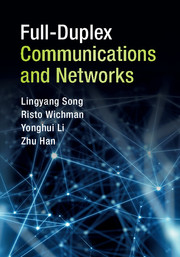Book contents
- Frontmatter
- Dedication
- Contents
- Preface
- 1 Basics of Communication Systems
- 2 Signal Processing and Theoretical Limits
- 3 Full-Duplex System Hardware Implementation
- 4 Full-Duplex MIMO Communications
- 5 Full-Duplex OFDMA Communications
- 6 Full-Duplex Heterogeneous Networks
- 7 Full-Duplex Cooperative Networks
- 8 Full-Duplex Cognitive Radio Networks
- 9 Full-Duplex Random Access Networks
- References
- Index
6 - Full-Duplex Heterogeneous Networks
Published online by Cambridge University Press: 16 March 2017
- Frontmatter
- Dedication
- Contents
- Preface
- 1 Basics of Communication Systems
- 2 Signal Processing and Theoretical Limits
- 3 Full-Duplex System Hardware Implementation
- 4 Full-Duplex MIMO Communications
- 5 Full-Duplex OFDMA Communications
- 6 Full-Duplex Heterogeneous Networks
- 7 Full-Duplex Cooperative Networks
- 8 Full-Duplex Cognitive Radio Networks
- 9 Full-Duplex Random Access Networks
- References
- Index
Summary
The continuous growth in the numbers of mobile users and the increase in data communication make deploying new techniques with increased data rates a crucial need. In other words, modern network topologies are required to give the required performance boost. Since decreasing the number of users in each cell, as well as decreasing the distance between the users and the base station, increases the total achieved capacity, therefore, small cells are required. However, it is well known that large cells are the cost-effective way to serve fast-moving users. Therefore, one solution to match these demands is to employ Heterogeneous Networks (HetNets). The main idea of HetNets is to densify the existing macro-cell by adding a mix of pico, femto and relay base stations to which users will be offloaded from the macro base station. This will help in increasing the network capacity in hot spots and in giving better coverage for both outdoor and indoor areas not covered by the macro network.
Furthermore, both the efficiency of utilizing the available communication resources and the capacity achieved by HetNets can be further improved by deploying Full Duplex (FD). Theoretically speaking, allowing the network nodes to simultaneously transmit and receive data at the same channel and in the same time slot achieves double the capacity achieved by Half Duplex (HD) communication when using the same resources. However, it must be mentioned that FD was considered unfeasible for a long time as the increase in networks’ capacity offered by deploying FD is restricted by the ability to suppress the self-interference which is caused by the node's transmission on the node's reception and results in a great degradation in the received Signal-to-Interference Noise Ratio (SINR). Recent evolution in self-interference cancellation techniques revived the attention to FD. As mentioned, adding FD communication to HetNets will improve the network efficiency and capacity. Accordingly, efficient resource allocation techniques are needed to fully benefit from the available resources and to overcome the challenges that arise from deploying FD to HetNets.
- Type
- Chapter
- Information
- Full-Duplex Communications and Networks , pp. 179 - 204Publisher: Cambridge University PressPrint publication year: 2017



